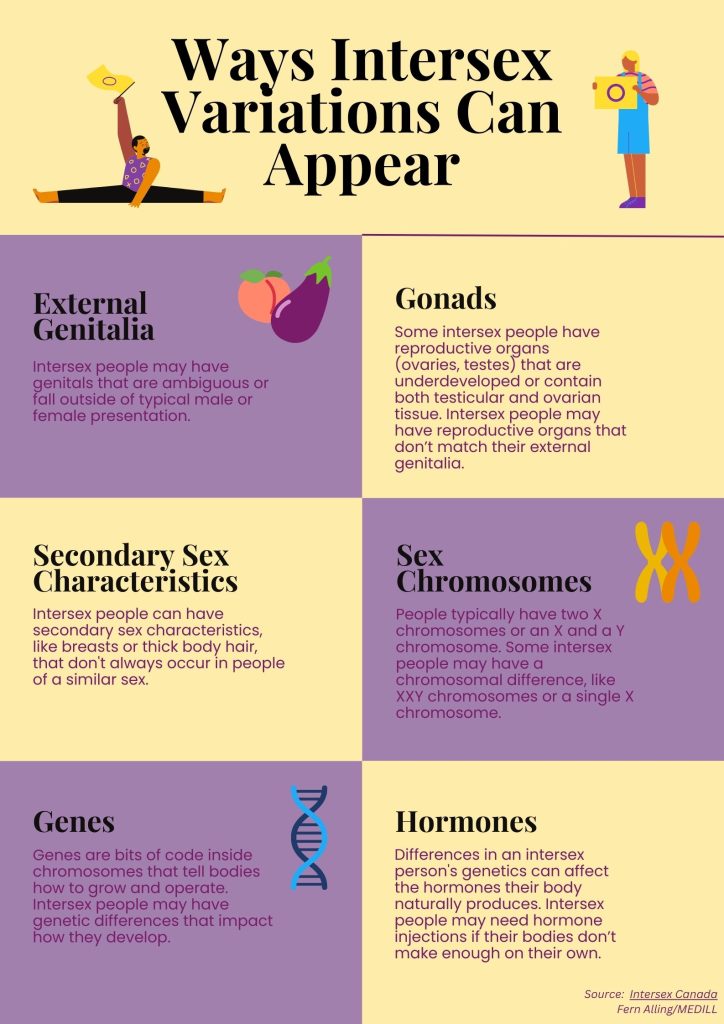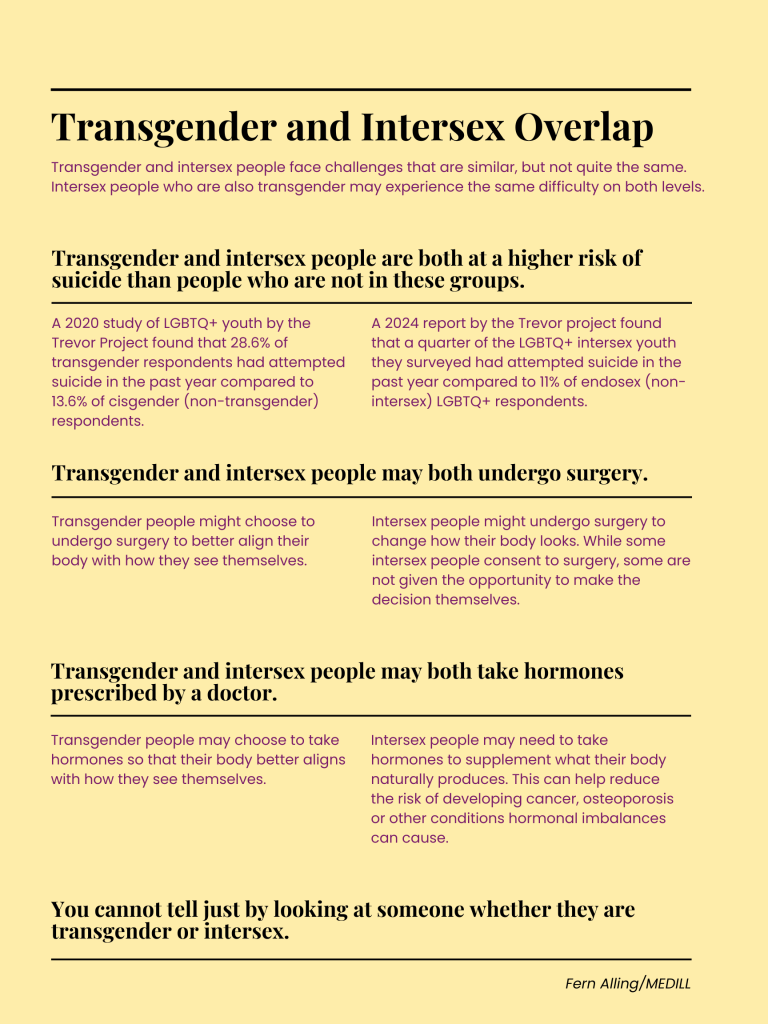By Fern Alling
Medill Reports
In the first two weeks of his second term, President Donald Trump signed eight executive orders that explicitly targeted transgender Americans. Some resulting actions – like restrictions on gender-affirming care for people younger than 19 years old – were temporarily blocked by federal judges. Others – like changes to passport markers – are still in effect.
These orders pose evident harm to the transgender community. But another group threatened by Trump’s actions is receiving less attention, advocates say.
“It’s not something that I can just stop talking about and it goes away,” said Nessa, a visual artist based in Maryland. “Being socially identifiable as someone who’s different in a way that politics don’t like right now is a little scary.”
Nessa, who asked to be identified only by her first name for safety reasons, is one of the estimated 5.7 million Americans who are intersex, not readily categorized as biologically male or female. Anti-transgender legislation like the recent executive orders threatens the health and well-being of the intersex as well as the transgender community, experts say.
Binary sex definitions could deny aid programs for intersex Americans
One of the anti-transgender executive orders describes two sexes the federal government will recognize: male and female. “Male” refers to “a person belonging, at conception, to the sex that produces the small reproductive cell,” while “female” refers to “a person belonging, at conception, to the sex that produces the large reproductive cell.” These sexes, according to the order, are “grounded in fundamental and incontrovertible reality.”
Maddie Moran, communications director of intersex advocacy group InterACT, said these definitions raise questions for intersex Americans.
“There are intersex people who have ovotestes, where they might produce both types of reproductive cells,” they said. “Who are they under this executive order? Do they count as male or female? There are people who have no gonads. Where do they fit under it?”
Definitions of demographic categories like sex inform the way the government determines eligibility for certain aid programs, like those for young mothers. Nessa said some intersex people she knows are worried they won’t qualify for assistance anymore under the executive orders.
“If we legally don’t exist, that means they can just ignore us when it’s convenient,” she said.
What is intersex?
The term “intersex” is a blanket term for dozens of naturally occurring variations in human sex characteristics that can blur the lines between male and female. Intersex variations can relate to hormones, chromosomes, reproductive anatomy or some combination of the three. These variations are present at birth and do not develop over time.
It’s hard to keep count of the intersex population. Hospitals aren’t required to track how many intersex children are born. Even if they were, intersex traits may not become apparent until puberty, if at all.
Most advocacy groups, government organizations and medical organizations put the number of intersex people at 1.7% of the world population. But, Nessa said, that doesn’t mean intersex people are rare.
“That’s one person in a small high school graduating class. That’s a few people in the shopping mall at any given time,” she said.

Intersex and transgender experiences are different, but related
There is notable overlap between the transgender and intersex communities. A 2024 report by The Trevor Project found 75% of the intersex youth surveyed also identified as transgender. At the same time, the two are not synonymous.
“Trans identity is a sense of self, like, ‘This is who I am. This is how I want to be in society. This is how I want society to receive me,’” said Sean Saifa Wall, an intersex advocate and co-founder of the Intersex Justice Project. “Intersex is biology. It’s literally the nuts and bolts, the tissue, the organs.”
Only one anti-transgender executive order, “Defending women from gender ideology extremism and restoring biological truth to the federal government,” contains the word “intersex.” But that doesn’t mean the rest of the orders won’t impact the community.
“Almost every single anti-trans bill targeted at trans individuals does negatively affect intersex people, whether or not that’s the intended target of the bill,” Moran said.
State bills are publicly debated and voted on, unlike executive orders, which only need to be signed by the president to take effect.

Removing intersex people from government research exacerbates an existing knowledge gap
The intersex population was largely ignored by the federal government until recently. The Department of Health and Human Services released the first federal report on intersex health, “Advancing Health Equity for Intersex Individuals,” on Jan. 16. Its findings: 47.8% of intersex people surveyed delayed getting emergency health care, and 65.4% delayed getting preventative health care because of negative medical experiences in the past.
The report called for greater civil protections for intersex people, government research into policies that can improve intersex health and more data collection on intersex individuals. It was removed from the Health and Human Services website after the Trump administration took over, about a week after its release.
Anti-transgender legislation doesn’t prevent intersex youth surgeries
Dr. Ilene Wong, a urologist who frequently sees intersex patients who underwent surgery as minors, said the removal was “horrifying.” Wong said it’s common practice for doctors to perform so-called cosmetic surgeries on intersex infants and youth to make their genitals appear more typically male or female.
While surgery is necessary in some life-threatening instances, intersex advocates and health groups like the American Academy of Family Physicians and the American Academy of Pediatrics argue nonessential surgeries should be delayed until the intersex patient can make an informed decision.
Wong’s first exposure to the cost of improper intersex care happened when she was a resident. She said she participated in a surgery to remove gonads from a young woman with androgen insensitivity syndrome. Only once the surgery was complete did she realize the patient wasn’t aware of the consequences.
“No one had really consented this girl properly. She had no idea she would need to be on hormones, likely that she would be set up for osteoporosis,” Wong said. “She was essentially menopausal, and she was 17 years old.”
The fifth executive order targeting transgender people describes gender-affirming care as “chemical and surgical mutilation.” Alithia Zamantakis, a research assistant professor at Northwestern University’s Institute for Sexual and Gender Minority Health, said nonconsensual surgeries on intersex youth are more akin to mutilation than the elective surgeries some transgender youth undergo.
“Intersex surgeries cause lifelong harm to a child. Gender-affirming care has lifelong benefits,” she said. “And yet we ban gender-affirming care and promote intersex surgeries.”
Legislation outlawing gender-affirming care for minors in at least three states – Georgia, Kentucky and South Carolina – contains explicit exceptions for surgeries on intersex youth. There is no language exempting intersex surgeries from gender-affirming care in the executive order. However, according to Moran, intersex surgeries are still legal in the U.S.
The trans panic deputizes body police
Impacts of anti-transgender legislation aren’t limited to the hospital or the courtroom. Increased attention to people who don’t fit gender norms means higher scrutiny of their bodies.
The Salt Lake Tribune published a story about a Utah high schooler whose sex was investigated without her knowledge. She soundly beat other female athletes at a competition, and their parents complained to the Utah High School Activities Association. The organization determined she was not transgender after reviewing records going back to kindergarten.
Nessa was told she couldn’t use the women’s bathroom and was directed to the men’s bathroom instead.
“It’s not just a thing of, keep your head down and you’re fine,” she said. “It’s being told you don’t qualify for things and being made to do invasive stuff to prove that you are who you assert yourself to be.”
What’s next for intersex advocacy groups?
Human and LGBTQ+ rights groups including the ACLU and Lambda Legal are pursuing various lawsuits against the anti-transgender executive orders. Moran said they think the orders’ reliance on unscientific conclusions could be advantageous in a legal setting.
“These are unenforceable at the end of the day, so there’s even more grounds to fight it,” they said.
In the meantime, intersex Americans will be anxiously waiting.
“In some cases, the medical care that someone receives, trans or intersex, is a matter of life or death,” Nessa said. “For a lot of us in both communities, that’s a concern, that our bodies will suffer because of this legislation.”
Fern Alling is a graduate student at Medill specializing in health, environment and science reporting. You can connect with them on LinkedIn.

